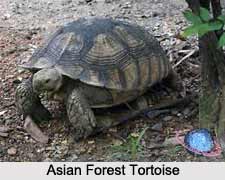 Asian Forest Tortoise is an Indian Reptile that bears a scientific name "Manouria emys", which also known as Asian Brown Tortoise is widely found in Asian countries and the Indian states. According to the molecular and morphological studies, this species-Manouria emys is believed to be among the most primitive of living tortoises, based on molecular and morphological studies. Asian Forest Tortoise is the largest tortoise in mainland Asia.
Asian Forest Tortoise is an Indian Reptile that bears a scientific name "Manouria emys", which also known as Asian Brown Tortoise is widely found in Asian countries and the Indian states. According to the molecular and morphological studies, this species-Manouria emys is believed to be among the most primitive of living tortoises, based on molecular and morphological studies. Asian Forest Tortoise is the largest tortoise in mainland Asia.
Concentration of Asian Forest Tortoise
Asian Forest Tortoise is a species of tortoise found in Indian states like Assam, Meghalaya, Dispur, Gwahati, Manipur, Tripura, Nagaland, Mizoram and the other Asian countries like Bangladesh, Myanmar, Thailand, Malaysia and Indonesian places like Sumatra and Borneo.
Weight of Asian Forest Tortoise
Asian Forest Tortoise is the largest tortoise in mainland Asia. The largest adult Asian Forest Tortoise of the northern subspecies can reach 25 kg in the wild and much more than that in captivity.
Shell of Asian Forest Tortoise
The shell of Asian Forest Tortoise is considerably depressed, its depth not half its length; anterior and posterior margins reverted, more or less strongly serrated; nuchal present; two supracaudal shields; dorsal shields concentrically striated, often concave; vertebral much broader than long and at least as broad as costal. Plastron is large, gular region is somewhat produced and usually notched, hind lobe deeply notched; the pectoral shields may be widely separated from each other, or from a short median suture; auxiliary shield very small, inguinal large.
Structure of Asian Forest Tortoise
The head of Asian Forest Tortoise is moderate; two large prefrontal shields and a large frontal; beak not hooked; jaws feebly denticulate, the alveolar surface of the upper jaw with a strong median ridge. Forelimb is interiorly with very large, bony, pointed, imbricate tubercles, forming four or five longitudinal series; hind limb with very large bony tubercles on the plantar surface, with others larger, conical, and spur-like on the heel, and a group of still larger conical tubercles on each side on the back of the thighs. The adult Asian Forest Tortoise is dark brown or blackish; carapace of young yellowish brown, with dark-brown markings.
Eggs of Asian Forest Tortoise
Asian Forest Tortoise with a scientific name "Manouria emys" is the only tortoise which lays its eggs above ground in a nest, which the female constructs of leaf litter. The female Asian Forest Tortoise uses both front and rear legs to gather material for the nest and lays up to 50 eggs deep inside it. The female Asian Forest Tortoise then sits on and near the nest to protect it, and will `chase` predators and intruders away.











